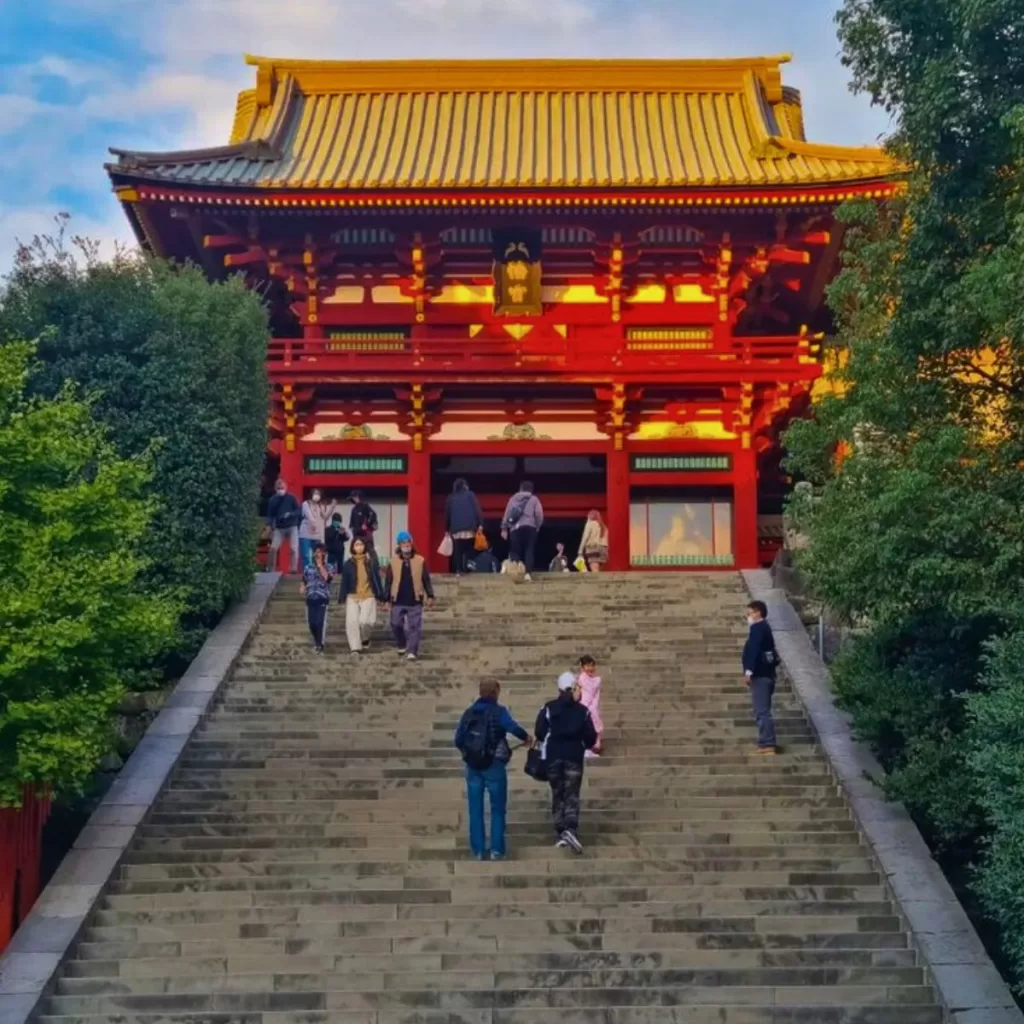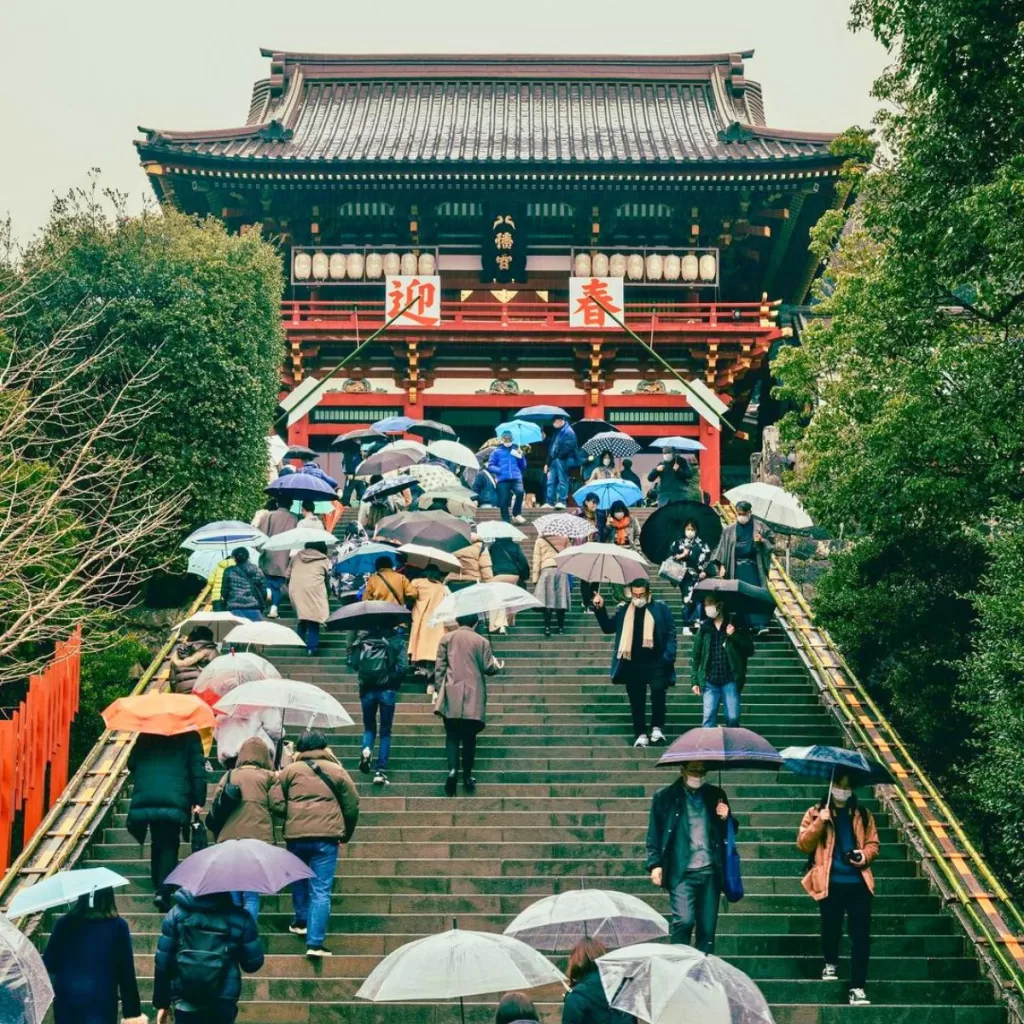Tsurugaoka Hachimangu Shrine: A Tranquil Oasis in Kamakura
Overview of Tsurugaoka Hachimangu Shrine
Tsurugaoka Hachimangu Shrine, also known as Tsurugaoka Hachimangū, is one of Japan’s most essential and historical Shinto shrines. It is located in Kamakura city in Kanagawa prefecture, a place gaining rapid popularity in Japanese travel guides for its profusion of shrines and temples. Kamakura is easily accessible by train from Tokyo, making it an inevitable stop on any Japan travel itinerary.

Worship at The Shrine
The shrine is devoted to Hachiman, the Shinto and Buddhist deity of war who served as the tutelary god of samurais. Hachiman represents the Minamoto clan, famous warrior elites in Japanese history and culture. Especially Minamoto no Yoritomo, who established the Kamakura shogunate, was strongly linked to this significant shrine.
History of Tsurugaoka Hachimangu Shrine
The shrine’s history dates back to 1063, when Minamoto Yoriyoshi founded it. Originally situated at a different location, the shrine was transferred to its current site in Kamakura by Yoriyoshi’s grandson, Yoritomo, in 1180. This move signified the establishment of Kamakura as the undeniable center of the Kamakura shogunate.
Yoritomo wasn’t just founding a samurai rule but starting a new era in Japanese culture. The establishment of Tsurugaoka provided a communal hub for this flourishing cultural landscape, which became the heart of Kamakura’s samurai society.

Tsurugaoka Hachimangu Shrine Grounds
Embarking on a visit to the shrine begins with a charming stroll along the approach to this spiritually significant site. This pathway starts from JR Kamakura Station’s east exit and extends for almost 2 kilometers, leading visitors through three Torii gates that symbolize entry into the sacred realm.
En route to the shrine stands Wakamiya Ōji Street, lined with cherry trees that bloom beautifully in spring. Around halfway down the avenue lies the dankazura, an elevated pathway bordered by blooming cherry trees leading up to the symbolic second torii gate called Daimyojin Torii. Further on lies the third red-lacquered Torii gate framing your first view of steps leading up to the main shrine complex.
Shrines within The Tsurugaoka Hachimangu Complex
Aside from the main hall at the top of a wide stairway, which grips attention at first sight due to its overwhelming solemnity and dignity, other smaller structures also draw considerable attention. The complex contains over a dozen sub-shrines, such as Maruyama Inari Shrine, characterized by its dozens of torii gates; Wakamiya Shrine, recognizable with its dancing stage; and Shirahata Jinja, dedicated to Emperor Ojin, whom some identify with the deity Hachiman.
The shrine area also houses two ponds – Genpei-ike ponds, each representing the Minamoto (Yoritomo) clan (Genji Pond with three islands) and the Taira clan (Heike Pond with four islands). These clans famously battled each other during the late Heian Period, which resulted in Minamoto’s victory, leading to the establishment of the Kamakura government.
Another prominent element is an ancient ginkgo tree believed to be over 1000 years old standing near Maiden – an open-air stage used for rituals and performances like Bugaku (Traditional court music dance) held during festivals organized at this divine place.
Visiting Tsurugaoka Hachiman Shrine
Visitors usually time their visit for Hatsumode – the first shrine visit of the New Year, when millions engage in traditional practice offering prayers seeking happiness and good health for the coming year.
Another attraction enhancing Shine’s fame is the horseback archery ritual – Yabusame, held annually on the second Sunday of September during the autumn festival conducted annually since it was first decreed by Yoritomo over eight centuries ago.
To enrich your experience further, there are several museums nearby, including the Kamakura Museum of National Treasures, housing a variety of Buddhist statues, mostly dating back to the late 7th and 13th centuries, and the Museum Of Modern Art, exhibiting modern Japanese artwork amidst scenic natural beauty.
Please give yourself plenty of time when visiting this historical gem. There are too many things worth exploring apart from soaking up its serene atmosphere contrasting with its bustling nature-filled approach, generating cultural fusion air, adding unique flavor, and making your trip memorable forever.
FAQs
- What is Tsurugaoka Hachimangu Shrine?
Tsurugaoka Hachimangu Shrine is an important Shinto shrine located in Kamakura, Japan. It is dedicated to Hachiman, the legendary god of war.
- Where is Tsurugaoka Hachimangu Shrine located?
Tsurugaoka Hachimangu Shrine is situated in the city of Kamakura. It can be easily accessed from Kamakura Station or JR Kamakura Station.
- Why is Tsurugaoka Hachimangu Shrine considered important?
Tsurugaoka Hachimangu Shrine holds great historical and cultural significance as an important shrine in Japan. It is one of the most revered and important cultural landmarks of Kamakura.
- What can I expect during a visit to Tsurugaoka Hachimangu Shrine?
During your visit to Tsurugaoka Hachimangu Shrine, you can witness various traditional ceremonies and events. The shrine visit of the year is a particularly special occasion, where people gather to pay their respects and celebrate.
- What is the history behind the Tsurugaoka Hachimangu Shrine?
Tsurugaoka Hachimangu Shrine has a rich history dating back to the 12th century. It was originally dedicated to Hachiman by Minamoto no Yoriyoshi, the first shogun of the Kamakura.
- Are there any other shrines within Tsurugaoka Hachimangu’s grounds?
Yes, within the grounds of Tsurugaoka Hachimangu Shrine, you can find the Hataage Benzaiten Shrine and the Iwashimizu Hachimangu Shrine at Kamakura. These shrines add to the spiritual aura of the overall shrine complex.
- What is the significance of the terrace at the top of the shrine?
The shrine is constructed on a terrace at the top of a hill. This approach to the shrine symbolizes the spiritual journey undertaken by visitors as they ascend towards the main sanctuary.